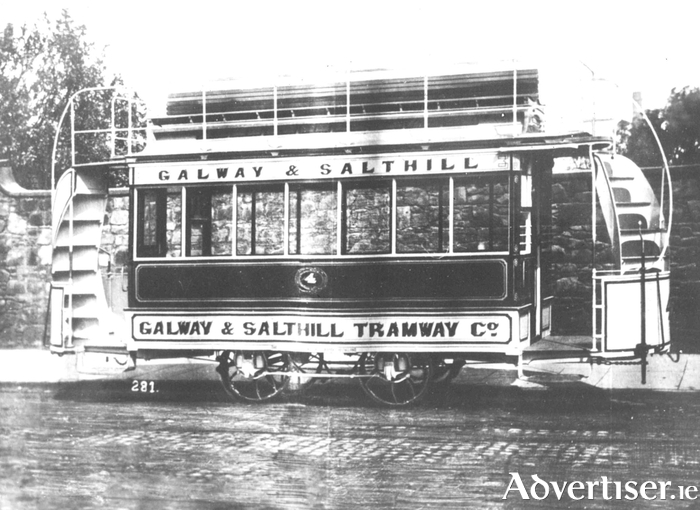The mid-19th century was an era of little movement of people for social or pleasure purposes. In the post-Famine era, it was only business people of necessity, those who were emigrating or those whose financial circumstances allowed who travelled. Railway travel had come Galway in 1851 and there were a few horse drawn omnibuses operating between the city and the village of Salthill, which was really a rural backwater. But, it was becoming a fashionable place to live and was developing as a tourist destination. It was therefore no surprise when a tramway system between the city and the village was proposed.
The Galway and Salthill Tramway Company Ltd was incorporated in 1876 and applied for consent to construct a line linking the two areas. The line was to run from Eyre Square to what was then known as Blackrock Road in Salthill (The Prom today ). One hundred men were employed in Menlo Quarry at 12 shillings a week to prepare limestone setts on which the track would be laid. These eventually proved to be inefficient and were replaced by granite setts.
The line was single track with passing places, roughly 250 yards apart, at Eyre Square corner with Williamsgate Street, West Bridge, Lower Dominick Street, William Street West, Montpelier corner, Lower Salthill, at the Ballinasloe Public House and at the Blackrock Road terminus. The works on the line would greatly enhance the roadway along the way.
The three-foot gauge tracks (the metals being 71 pounds per yard, or 35kg per metre ) carried double decked trams which seated 18 passengers on each deck. Single deck cars were hauled by just one horse while the double-deckers required a pair of horses to pull them. An additional horse was staged at Kingshill to assist on the stiff gradient there. The horse, known as a “cock horse” was also used as a brake-assist to heavily laden trams on the downward slope on the return journey.
They secured premises at Forster Street for stabling and as a works garage. The first order for cars was for six four-wheel double-deck open top vehicles which were supplied by Starbuck of Birkenhead. Because of the low clearance of over bridges on the Midland Great Western Railway, the tramcars were delivered by sea. Four of them were on hand for the opening. The cost of a pair of these cars was £340. The bodies had seven windows per side, longitudinal cushions inside and the usual back-to-back wooden seating on top. The top deck had substantial railings and large advertising boards which were known as “decency boards” as they prevented anyone from looking up the skirts of ladies seated on that deck. The trams sported a livery of olive green with white rocker panels.
From the opening day, the cars ran every half hour in winter time, increased to every 20 minutes in summer. The fares charged were two pence for any length of the two and a half mile route with children charged just one penny. Early morning commuters were catered for from 6am until normal service commenced at 7am. The fare for those early bird cars was a halfpenny per mile. Local businesses hired advertising space on the sides of the cars.
The first major crisis for the company came in 1911 when the staff went on strike. A second strike dealt a severe blow to their finances and then, when World War I broke out, the British Army commandeered many of the company’s best horses (they had 25 ) and this along with the increased competition from motor buses sounded the death knell for the trams. Tenders were invited for the purchase of the assets but none were acceptable and the company ceased trading in April, 1918.
Our first photograph is of a newly arrived tram and gives us a very good idea of its size. It looks very elegant and it must have been a pleasure sitting on top in good weather watching the world go by at a gentle clip-clop pace. It was taken at one of the bypasses and as you can see, the ‘decency boards’ had yet to be fitted. Our second image was taken at the terminus in Salthill, again at one of the bypasses. The white wall on the right was the end wall of the Eglinton Hotel and there were, as yet, no buildings to the west of it but the telegraph poles had already reached Salthill.
All of the above is from a wonderful article by Michael Hurley which appears in the latest edition of The Galway Archaeological and Historical Society journal. It is one of several fine pieces in this issue, which is edited by Dr Jackie Uí Chionna and is another important addition to any Galway library. Annual membership of this society is only €20 which includes the journal and notices to all of their events. It is an august institution which has been producing journals for over a century and is worthy of our support. To apply for membership, simply go to www.gahs.ie or their postal address is the Galway Archaeological and Historical Society, Archives Services, James Hardiman Library, University of Galway.
Michael Hurley has also published a fine booklet titled The Galway and Salthill Tramways Company, 1879–1918 which is profusely illustrated. He has some copies left at €12 each plus €3 for postage. Highly recommended. You can contact him at [email protected].

